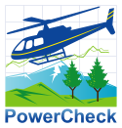Power Check works in the same manner as plotting
the charts manually. The program uses the flight manual chart and
procedure.
Each graph was enlarged so that it may be
measured down to less than a single degree of turbine temperature,
or to within 0.1% of torque, even less for Ng values. The
intersection of each element of the chart was measured in a 3D
fashion, and then this data is placed in a database table. When you
enter your test data, the table is read into memory, and a
precise result can be calculated.
Many of the flight manual procedures require you
to alter the input data slightly for things such as sand filters
or particle separators. Some helicopters manuals specify torque adjustments
depending on air speed, or adding / subtracting the OAT reading
for different engine models fitted. Power Check makes all these
adjustments for you.
The data from your helicopter's test is checked
for errors, flight manual limitations and validity, both before
and after plotting on charts.
The result is calculated to within 1°C turbine
temperature, 0.1% of engine torque, and 0.05% Ng speed. However,
the instruments fitted to the helicopter often don't provide that
kind of accuracy, and it's not possible to fly your helicopter to
within such tiny margins of torque. So the end result depends
greatly of how well the aircrew performs the test, and records
the instrument values.
One of the best features is that Power Check
doesn't make any human errors. Humans make errors like
forgetting the quirks of each chart procedure, and worst of all using the
blunt end of one's index finger as a chart plotting tool.

